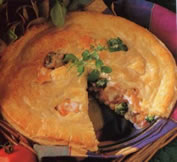| COOKING
METHODS
(4 of 9) |
Hospitality
and Catering |
|
 |
 |
| Unlike the pork pie, meat pies classically do not have a base, the meat such as steak and kidney or chicken is placed with some seasoning, chopped onion and stock into the pie dish, line the edge of the pie dish with a strip of paste some 2 cm wide, cover with cold savoury paste, seal well and make a hole in the centre. |
 |
| Make a slightly thickened filling first, having cooked the meat slowly, correct the seasoning and colour, cover in the usual way and bake in a moderate oven until a light golden crust results. |
| Certainly the British prefer a thickened filling to meat pies rather than the classical stock and meat previously described. |
| Meat and potato pies, lamb and mutton pies can also be produced, in addition vegetable pies are very popular for vegetarian diets, either crisp seasoned mix of vegetables, bound with a light cream sauce or vegetable veloute, Portugaise or other flavoured sauces. |
|
|
|
|